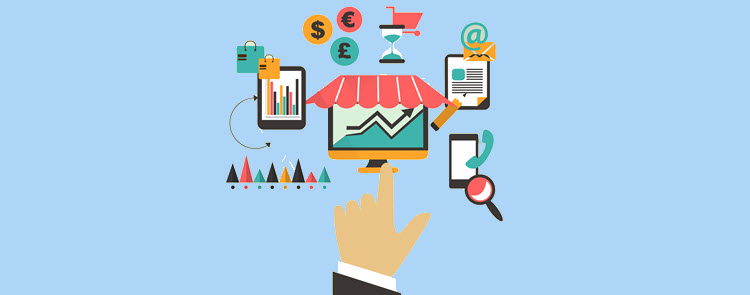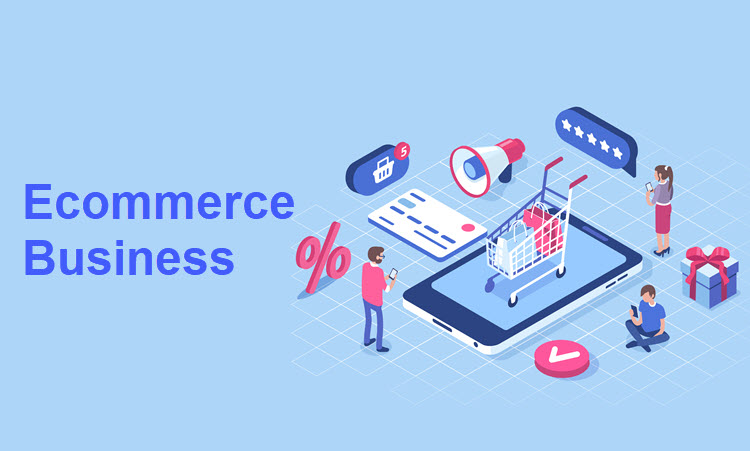The number of people buying and selling things online has risen rapidly in the last ten years. Statista reports that by 2025 global ecommerce sales will reach $7.4 trillion.
This rapid growth has been driven by the spread of internet access, technological advances, and a greater choice of payment options to suit different customer preferences. Most notable amongst these factors has been the COVID-19 pandemic, which forced even reluctant merchants and buyers online.
Ecommerce is no longer just another way to sell your product but a requirement for both well-established brands and budding entrepreneurs.
This article explains what ecommerce business is, what types of ecommerce models there are, and what the future holds for online businesses.
What Is Ecommerce?

Ecommerce (electronic commerce) refers to any activity of selling or buying items online. It includes all the processes that enable the transfer of goods, data, and/or assets in order to complete online commercial transactions.
Primarily, ecommerce is associated with the sale of physical goods online. However, ecommerce refers to any online commercial transaction. An ecommerce sale may be B2B, B2C, C2C and even C2B.
Types of Ecommerce Models
Based on the type of interaction between merchants and customers, there are four ecommerce models.
Business to Consumer (B2C)
The business-to-consumer (B2C) ecommerce business model refers to companies selling products and services to customers who are also the end-users. Companies following this business model are labeled B2C companies.
Business to Business (B2B)
Business-to-business (B2B) companies sell goods or products to other companies. Wholesalers buying supplies from manufacturers and retailers purchasing those same goods from wholesalers are examples of B2B transactions.
Note: If your customers are other companies, read our blog post to learn more about how to increase B2B sales.
Consumer to Business (C2B)

In the C2B ecommerce business model, customers sell products or services to companies. Platforms such as Fiverr and Upwork, where freelance professionals offer their services, are an example of C2B collaborations. Other examples include paid customer reviews or testimonials and influencers who recommend products for a fee.
Consumer to Consumer (C2C)
Consumer to Consumer (C2C) is a business model in which consumers sell products or services to one another. C2C ecommerce business transactions are typically carried out via specialized platforms for online selling, such as eBay or Craigslist. A customer places a product on an ecommerce marketplace, where other consumers can browse and make purchases.
Advantages and Disadvantages of Ecommerce

The ecommerce business model comes with its set of advantages and disadvantages.
Advantages
These are the advantages of ecommerce:
- Space no longer matters. The most prominent feature of ecommerce is that the limitations of space are no longer a deciding factor. Ecommerce companies reach buyers regardless of their physical location, and any product can find a global market. Additionally, shelf space and store size are no longer a limiting factor as online merchants can put up for sale their entire stock.
- Faster purchase and sales. Instead of looking around brick-and-mortar stores, online buyers can quickly and easily find what they need. They also make quicker decisions, as product ratings and reviews are readily available on the web. Merchants can quickly place products for sale on their ecommerce website, change active offers, give special discounts, replace items in stock, and order new supplies.
- Affordability. Starting an ecommerce business is less expensive than renting, equipping, and opening a physical store. Also, the maintenance and utility costs are significantly lower for an online store.
- Product catalogs. Ecommerce merchants create product catalogs more efficiently, and their in-house or outsourced web developers easily add or remove items from their product listings. With an ecommerce platform, you can leverage ready-made templates for product catalogs, removing the need for developers altogether.
- Scalability. Upscaling an e-store is faster and simpler than enlarging a physical store. However, high shopping seasons demand preparation in the form of additional inventory management and extra work hours from developers.
- Higher profits. The profit margin of ecommerce businesses is higher than those of physical stores because online merchants can sell multiple items in the space of time required to complete a single purchase in a brick-and-mortar store.
- Precise targeting. Using tracking and AI tools, like ecommerce chatbots, allows merchants to target visitors, one-time buyers, and recurring customers more precisely. Based on customer purchases, merchants can create a buyer’s profile, predict their potential future needs, and offer cross-selling and upselling options.
- Easy retargeting. Ecommerce opens numerous opportunities for merchants to retarget customers after various activities, such as cart abandonment. Once a customer leaves their email address, the merchant can retarget them with special offers, discounts, and personalized deals.
- Customer feedback. Buyers can leave comments, ratings, and reviews on the merchant’s website or ecommerce platforms. Consequently, future buyers get a better insight into the merchant’s reliability, and the quality of their products, while merchants get social proof.
- Quick two-way communication. Ecommerce enables fast and purposeful two-way communication between merchants and customers. From ecommerce customer support that resolves customers’ issues quickly to buyers’ post-purchase comments, ecommerce improves the entire customer journey.
Note: Find out more about the omnichannel customer journey in our article Omnichannel Customer Journey: All You Need to Know.
- Cross-border sales. Running a local brick-and-mortar store typically means working within a limited target market. Conversely, launching an ecommerce store or any other form of ecommerce business gives you a chance to attract customers across the globe.
- Customer base expansion. The potential for customer base expansion in ecommerce is vast. New prospects constantly keep appearing, looking at products, and interacting with the ecommerce business in question.
- Efficient supply chain. In ecommerce, inventory and warehouse management, as well as the entire supply chain, are carried out automatically. When an item is sold, software tools notify warehouse operators that it should be ordered from suppliers and added to the warehouse.
Disadvantages

Running an ecommerce business also has some disadvantages.
- Security. Ecommerce business transactions include ecommerce payment processing and managing customer payment data. Malicious actors are always looking for opportunities to exploit the payment data online businesses work with. Merchants need to work with experienced payment processors that offer cutting-edge tools for fast and secure credit card processing and meet all financial and legal regulations.
- Stringent regulation. Any handling of customer data requires merchants to strictly adhere to payment compliance regulations. Ecommerce legal regulations in the EU are different from policies in the US or individual Asian countries. Merchants aiming at international sales need to bear this in mind and ensure compliance with relevant market standards.
Note: For relevant information about European payment regulations, read our two blog posts: What are SEPA Payments and What Is PSD2
- No in-person purchase. In-person purchases have certain benefits, such as developing a personal relationship and enhancing customer loyalty. Ecommerce operations lack this direct human touch, which might deter some buyers.
- Delivery problems. Once a customer purchases a product, they expect to receive it quickly and in good shape. Buyers will place all responsibility for delays or problems with delivery on the merchant, even though shipping is often out of the merchant’s control.
Note: Fulfillment refers to accepting orders and packing, storing, and delivering goods to consumers. Merchants can arrange a collaboration with third-party fulfillment companies to handle all the fulfillment operations. Learn more about customer fulfillment from our post What Is Ecommerce Fulfillment.
- Shipping demands. The shipping market is a highly competitive environment. Statista reports that 46% of online buyers consider a two-day delivery time acceptable. However, buyers that pay extra for fast shipping expect to get the ordered goods within 24 hours. Merchants that fail to meet these requirements face a high churn rate.
- Complicated refund/return procedures. Returning a product to a brick-and-mortar store is less complicated than asking for an online refund or chargeback. When merchants dispute a refund request, customers can resort to filing a chargeback request that can turn become time-consuming and costly.
Note: Learn how to calculate Gross Merchandise Value in ecommerce to assess how well your ecommerce business is performing.
Examples of Ecommerce
The term ecommerce comprises various types of business models.
Wholesale

Wholesale refers to commercial operations in which suppliers or manufacturers sell goods in large volumes to retailers. Wholesale items are sold at a lower price than what the retailer ultimately charges the end-user.
Retail
Retail implies that merchants buy products from suppliers or manufacturers at discounted prices to sell them to customers at regular market prices without an intermediary. Retail is conducted via multiple sales and distribution channels.
Crowdfunding
Crowdfunding refers to gathering capital from various people for a limited interval to fund a new enterprise. It utilizes the simplicity and availability of different social media and digital crowdfunding platforms to grow a vast network of stakeholders and investors.
Dropshipping
In dropshipping, merchants do not keep the goods they sell in stock. Instead, they buy items from the importer or the product manufacturer, who then sends the products to the consumer on the merchant’s behalf. The merchant does not have any direct contact with the dropshipped products.
Subscription

In a subscription business model, merchants sell products or services on a recurring basis. Customers pay a certain monthly or annual subscription in exchange for goods or services. Customers need to agree to a particular set of terms and conditions when subscribing to products or digital services. These include the duration of the subscription, the payment date, the cancelation policy, and other provisos. Subscribers typically authorize merchants to collect automatic payments throughout the subscription.
Digital Products
Digital products are ecommerce items purchased, distributed, and consumed in electronic form. Video games, music, online videos, tutorials, and software tools are only some examples of digital products that can be purchased and used online.
Physical Products
Physical products are tangible items in liquid or solid form that have weight, height, and a specific size. Once purchased online, they need to be delivered physically to the buyer.
What Is the Future of Ecommerce?
With billions of people worldwide already using ecommerce services, ecommerce is projected to have a bright future. A report published by the US International Trade Administration shows that global ecommerce retail sales will experience seamless, steady 8% growth between 2020 and 2024.
The COVID-19 pandemic has contributed to a leap in ecommerce sales worldwide, accelerating further the development of an already booming industry. In an example of this growth, food delivery services in France have grown by 24% since the outbreak of the pandemic, Statista reports. In Spain, half of the surveyed respondents said they are planning to keep buying food online and use delivery services even when the pandemic ends.
By 2027, the global cross-border ecommerce market will reach $1.5 trillion, compared to 532.7 billion in 2020. Responding to these trends, many merchants are exploring new markets and adapting their services to newly generated leads. As more people gain access to mobile phones and digital payment options in Africa, Asia, and South America, ecommerce merchants can expect a surge in the number of buyers from those regions.
As for technological advancements, we can expect artificial intelligence (AI) to improve customer behavior tracking. Augmented reality (AR) will also play an essential role in helping customers visualize products virtually, enhancing the buying process, and eliminating the problem of trying before buying.
Additionally, the development of the metaverse and other similar virtual platforms will attract more people to pay and use products completely set in a virtual space.
Note: Check out more ecommerce trends in our blog post Ecommerce Trends You Need to Know about in 2022.
Conclusion
Ecommerce business is the future of business. From online purchases and B2B payments to digital products and services, ecommerce provides ample room for merchants to develop their enterprises and enjoy the benefits of a global online market.
